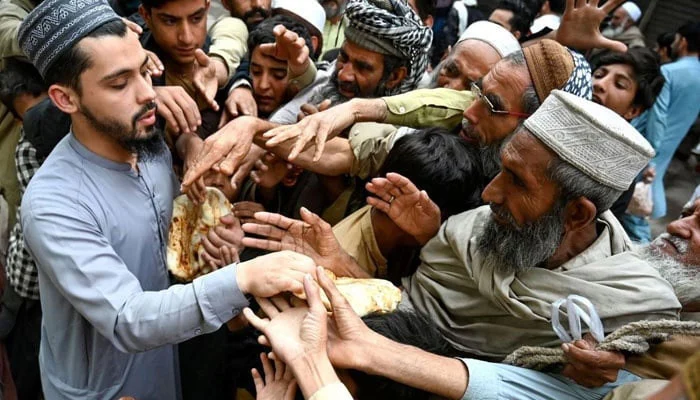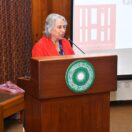By Dr Abid Qaiyum Suleri
Published in The News on October 10, 2025
The World Bank’s latest report, ‘Reclaiming Momentum Towards Prosperity: Pakistan’s Poverty, Equity and Resilience Assessment’, delivers a sobering message.
After nearly two decades of progress, poverty is once again rising. The national poverty headcount has reached 25.3 per cent, up from 21.9 per cent in 2019, while under the World Bank’s updated lower-middle-income threshold of $4.20 a day, almost 45 per cent of Pakistanis are now counted as poor. This report attributes Pakistan’s poverty reversal to the combined effect of inflation, repeated climate disasters, macroeconomic instability and weak public services.
Roughly, 40 per cent of the households hit by the 2022 floods remain below the poverty line today. The Bank also notes that inequality of opportunity is widening. The bottom 40 per cent of the population is stuck in informal, low-productivity work, while the richest decile captures nearly half of the national income. The report highlights that growth has decoupled from welfare; each percentage point of GDP now yields fewer reductions in poverty than it did a decade ago.
While one may debate whether this resurgence of poverty stems from external shocks or from internal weaknesses, behind these numbers lies a larger reality. Like many other developing countries, poverty in Pakistan is also neither uniform nor linear. It is multidimensional, defined not only by the lack of income but also by deprivation in education, health, water, sanitation, energy and housing. It is about insecurity: of livelihood, of access and of safety from shocks. The poor pay more for less. They spend disproportionately on transport and energy, live in climate-vulnerable locations and are the first to lose assets when disasters strike.
Addressing poverty, therefore, cannot be left to social protection programmes alone. It requires a multisectoral approach, where fiscal, energy, agricultural, and environmental policies work in tandem rather than at cross-purposes.
This interdependence becomes even clearer when viewed through the lens of climate change, which has emerged as a multidimensional shock cutting across all sectors of life and economy. When a flood destroys crops, livestock or housing, the poor lose both income and assets. When heatwaves reduce labour productivity, it is the daily-wage earner who earns less or falls ill. Rising food and energy prices, amplified by climate-induced supply shocks, hit low-income households hardest. Those already struggling to meet basic needs face repeated crises that prevent them from recovering between shocks.
This nexus between poverty and climate risk makes Pakistan’s newly submitted Nationally Determined Contribution(NDC 3.0), more than a carbon-reduction plan. It can potentially be a poverty-containment strategy. The NDC pledges a 50 per cent cut in projected 2035 emissions, of which seventeen per cent is unconditional and the remaining thirty-three per cent contingent on international finance and technology support. The document outlines an investment requirement of about $565 billion, covering sectors such as power, transport, industry, water, agriculture, waste and disaster-risk management.
Much of this spending overlaps with what the World Bank identifies as urgent poverty triggers. The plan allocates around $139 billion to disaster-risk preparedness and resilience and $89 billion to universal water and sanitation coverage. Such investments, if pursued with focus and inclusivity, can directly reduce poverty. Flood protection and ecosystem restoration initiatives can safeguard livelihoods and assets. Upgrading the power sector through renewables and grid efficiency can stabilise energy costs for households and small enterprises. Expanding access to clean water and sanitation can reduce disease burden and time poverty, especially for women and children.
However, climate ambition does not automatically translate into social impact. If renewable expansion is financed through commercial debt and recovered through higher tariffs, the transition could become regressive rather than inclusive. Implementation capacity, especially at provincial and municipal levels, is another weak link. The NDC offers direction but needs a people-centred financing framework to deliver results where they matter most.
That bridge can come from the International Monetary Fund’s Resilience and Sustainability Facility, or RSF, which Pakistan secured earlier this year. The $1.2 billion programme is designed to integrate climate resilience into macroeconomic policy. It encourages reforms in energy pricing, fiscal management and disaster-risk governance; areas that also shape poverty outcomes. Properly aligned, the RSF can shift the focus from austerity to adaptation.
Linking the RSF with NDC priorities would allow Pakistan to craft a coherent strategy that uses climate finance to achieve both resilience and equity. The two instruments already share complementary aims: the NDC provides a roadmap of investments, while the RSF offers a fiscal and institutional framework to implement them. If policymakers channel concessional RSF resources toward projects that simultaneously cut emissions and protect the poor (such as off-grid solar for small farmers, climate-smart irrigation, resilient housing and WASH facilities), the result would be transformative.
The cost of not acting on this nexus is reflected in the World Bank report. The 2022 floods alone caused more than $30 billion in damage and losses and pushed an estimated ten million people back into poverty. Each disaster cycle erases years of progress and multiplies fiscal stress. Reconstruction diverts resources from education, health and infrastructure, while new debt accumulates to finance recovery. As disasters grow more frequent, this treadmill accelerates: Pakistan ends up paying more to rebuild than it would have spent to prevent. Poverty then becomes not just a social challenge but a fiscal liability.
Resilience investments, by contrast, have positive spill-overs. They prevent losses, generate jobs and attract concessional finance tied to sustainability outcomes. A rupee spent on prevention can save several in relief and reconstruction. Integrating these measures within a coordinated poverty-climate framework is both economically rational and morally necessary.
To achieve this integration, Pakistan must move beyond piecemeal interventions. Poverty reduction, climate action and macroeconomic reform are not parallel tracks; they are facets of the same agenda.
The World Bank’s report has laid bare what Pakistan must now confront: a growth model that is consumption-driven, import-dependent, exclusionary and increasingly detached from human welfare. Reversing this trajectory demands more than short-term stabilisation. It requires a new growth paradigm – one that is resilient to shocks, inclusive in its benefits, climate-conscious in its design and centred on human welfare. Such a model must invest in people as purposefully as it invests in infrastructure, view adaptation and resilience as engines of productivity and treat sustainability not as a constraint but as an opportunity for renewal.
The NDC provides the strategic direction, the IMF’s RSF offers the financing pathway and the World Bank’s diagnosis supplies the moral and empirical urgency. If Pakistan can align these instruments into a coherent, pro-poor growth agenda, it can shift from managing crises to creating prosperity.
Rebuilding growth on the foundations of equity and resilience is the only way to reclaim the momentum the World Bank urges Pakistan to recover and to ensure that progress, once achieved, endures beyond the next flood.




